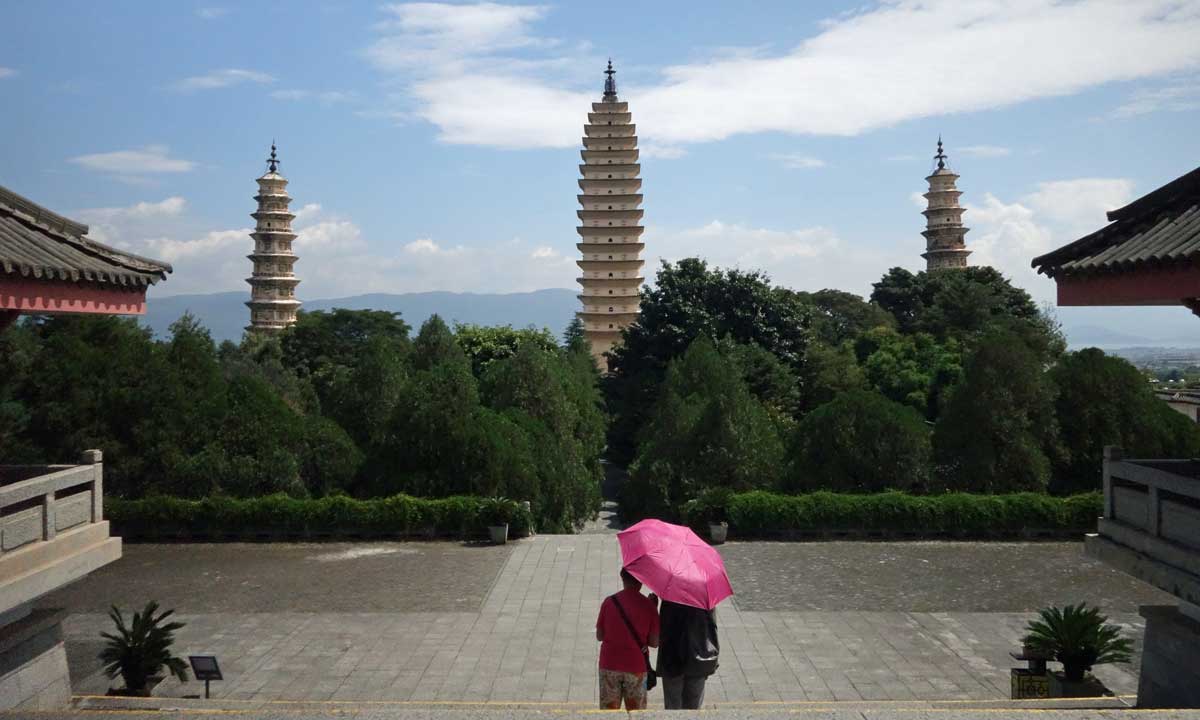The old town of Dali, beautifully located between mountains and lake, shows another side of China from the modern, bustling.
The town on the Ancient Tea Horse Road has retained a lot of its laid-back calm, even as it has turned into a popular tourist destination.
Dali is one of those towns on the Tea-Horse Road which are often quickly visited, somehow enjoyed – and hardly ever explored enough.
I myself, only just passing through on my exploration of the chile pepper in China, barely had the time to get some impressions, visit the main Buddhist temple in town, and see what local farmer’s markets are like.
It is a shame, given the history of this town.
Dali was not only an early major tourist spot when China had a backpacker’s hippie trail. Even earlier, it was the seat of the Bai ethnic minority’s kingdom of Dali.
The impressive Three Pagodas speak of its glory days as Buddhist kingdom.

The Three Pagodas of Chongsheng Temple
Chongsheng Temple is a name that you will hardly ever hear. The Three Pagodas are only a part of this temple complex, but they are older and much more impressive, by far.
As things so often go, such prominent features are much better known than the temples they belong to – and the temple was renovated, if not entirely rebuilt, but the pagodas survived turmoil and earthquakes.
People attribute it to their spiritual importance… but in modern times and as scholarly-minded people, we are much more interested in authenticity, in how things are now and came to be, and what that tells us about the world.
Now, the Three Pagodas are a major part of the tourist circuit to Dali and along the Tea Horse Road.
The view from above (and south of the entrance) shows the modern situation nicely: There is a large road going right past (and a large parking lot just off the view in the photo below).
And still, the surrounding town is still not built up much; the mountains nearby are lush and tempting.


The pagodas also serve as beacons around which some microexploration is a good idea.
Don’t just look at them and take selfies there (okay, I’m guilty as charged), but also take them as reasons to learn a bit more about their history and the history of the place where they stand.
A Little Dali History
Dali, as I mentioned before, used to be a Buddhist kingdom of the Bai minority people.
You know, the sort of religious kingdom one often, and almost only, hears about in reference to the Tibet of yesteryear.
Yunnan actually had quite a number of such ethnic minority kingdoms. They played their role in the turmoil of the Warlord Era of China between the Qing Empire and the time of the People’s Republic.
Even before, during the Qing Empire’s time, they (or at least their rulers and some of the local organization around them) still existed and had a function in the Chinese empire’s administrative system.
The Dali Kingdom, however, existed earlier, between 937 and 1254. It encompassed areas of Yunnan, southwestern Sichuan, and northern Myanmar.
Many of the Dali Kingdom’s rulers abdicated to pass on the reign and become monks, even as one can safely assume that the extent of their rule did not come about without military conquest.
The kingdom itself fell to the Mongol forces led by Kublai Khan, who established the Yuan Dynasty (which ruled China from 1271 to 1368).
From these times stems the look of Dali Old Town – after a fashion: It was restored to that state, with a moat surrounding it and city gates.
To what extent that architecture had survived and was restored or was more thoroughly “restored” (rebuilt), I cannot say. I can say that the modern look is a special one…
Dali Old Town Impressions
In rather typical Chinese (tourist town) fashion, some of the looks are a bit garish.
The neon lights of the city gate I encountered my first night in Dali looked a fair bit “Big Trouble in Little China,” I honestly think.

Still, the architecture is nice and the laid-back, if touristy, atmosphere is enjoyable.


Local Markets in Dali
Local markets, just off main (tourist) roads, truly retain the local flavor. These are not places that are made for tourists, but places where local inhabitants come to buy produce from local farmers.
As across Yunnan, the diversity of mushrooms available is great and thus very noticeable.





Then again, not everything has to be “authentic” in some misunderstood, traditionalist way.
Other Impressions
The prettiness also comes in modern ways, like in the boutique hotel I stayed in:

This, too, is modern China!
Still, the people and the random views can be very exciting to see…

… and to puzzle over.
I sure came away from Dali with great impressions – and more things, as always, to remember, to look closer, to learn more, and to get at home in this world.
If you want to know what I found there regarding the food and the chile pepper, read on over at ChiliCult!


Leave a Reply